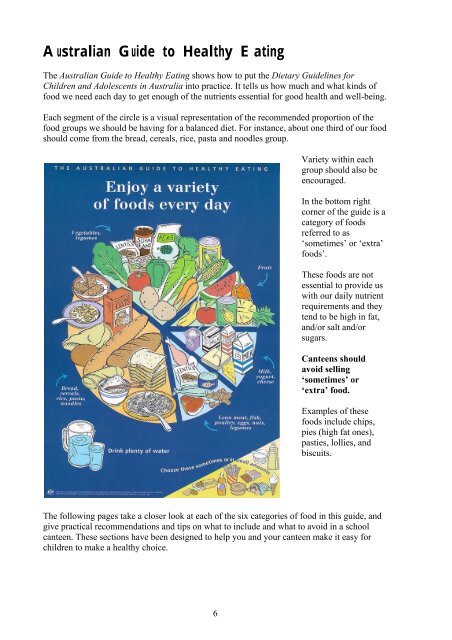Northern Territory School Canteen Guidelines - NT Health Digital ...
Northern Territory School Canteen Guidelines - NT Health Digital ... Northern Territory School Canteen Guidelines - NT Health Digital ...
Australian Guide to Healthy EatingThe Australian Guide to Healthy Eating shows how to put the Dietary Guidelines forChildren and Adolescents in Australia into practice. It tells us how much and what kinds offood we need each day to get enough of the nutrients essential for good health and well-being.Each segment of the circle is a visual representation of the recommended proportion of thefood groups we should be having for a balanced diet. For instance, about one third of our foodshould come from the bread, cereals, rice, pasta and noodles group.Variety within eachgroup should also beencouraged.In the bottom rightcorner of the guide is acategory of foodsreferred to as‘sometimes’ or ‘extra’foods’.These foods are notessential to provide uswith our daily nutrientrequirements and theytend to be high in fat,and/or salt and/orsugars.Canteens shouldavoid selling‘sometimes’ or‘extra’ food.Examples of thesefoods include chips,pies (high fat ones),pasties, lollies, andbiscuits.The following pages take a closer look at each of the six categories of food in this guide, andgive practical recommendations and tips on what to include and what to avoid in a schoolcanteen. These sections have been designed to help you and your canteen make it easy forchildren to make a healthy choice.6
Breads, cereals, rice,pasta and noodlesFoods in this group come from grains like wheat, oats, rice, rye, andcorn. They should be included in all light or main meals providedby the school canteen.Nutrients provided by foods in this group include carbohydrate forenergy, iron for strong blood, fibre to prevent constipation and help lower blood cholesterollevels, and vitamins. The wholegrain or wholemeal varieties give more fibre, vitamins andminerals and should be used as much as possible.In your canteenTry Breads: wholemeal, multigrain, high fibre, wholegrain, rye. Vary regularly the types ofbread available: rolls, pita, mountain bread, wraps, foccacia, lavash, Lebanese, bagels,raisin bread, fruit bread, fruit buns. Pikelets (plain or fruit), scones (plain or fruit), crumpets, low-fat fruit muffins, Englishmuffins, finger buns (no icing, thinly spread with margarine). Biscuits: Crisp breads, wheat biscuits, water crackers. Rice: boiled, savoury, stir-fried (served with plenty of vegetables), rice salad, rice cakes,rice dishes (1 cup per serve), risotto. Pasta: dishes (1cup per serve), pasta salads, lasagne, with bolognaise sauce (optional: addbeans and vegetables), canned spaghetti. Noodles: dishes (1 cup per serve), stir-fry.Avoid Cereal products listing hydrogenated fats, partially hydrogenated fats or artificialsweeteners among the ingredients. High sugar/high fat spreads (such as honey, jam, chocolate and hazelnut spread). Muesli or health bars that are high in fat. Confectionery. Chocolate and carob coated bars. Cream and chocolate biscuits, high fat cracker biscuits. Sweet snacks: Danishes, doughnuts, jellies, cakes, slices. Fried noodles.7
- Page 2 and 3: The Northern Territory School Cante
- Page 4 and 5: Why have school canteen guidelines?
- Page 8 and 9: Vegetables, legumesVegetables come
- Page 13 and 14: Extra foods (those with limitednutr
- Page 15 and 16: General menu suggestionsHot foodsBu
- Page 17 and 18: How to market healthy foodsMake the
- Page 19 and 20: MythFactMythFactMythFactMythFactMyt
- Page 21 and 22: Food hygiene• Pack foods carefull
- Page 23 and 24: Storage temperature and timeFrozen
- Page 25 and 26: Where to get more informationNutrit
- Page 27: Useful websitesWA School Canteens A
- Page 30: NOTES30
Australian Guide to <strong>Health</strong>y EatingThe Australian Guide to <strong>Health</strong>y Eating shows how to put the Dietary <strong>Guidelines</strong> forChildren and Adolescents in Australia into practice. It tells us how much and what kinds offood we need each day to get enough of the nutrients essential for good health and well-being.Each segment of the circle is a visual representation of the recommended proportion of thefood groups we should be having for a balanced diet. For instance, about one third of our foodshould come from the bread, cereals, rice, pasta and noodles group.Variety within eachgroup should also beencouraged.In the bottom rightcorner of the guide is acategory of foodsreferred to as‘sometimes’ or ‘extra’foods’.These foods are notessential to provide uswith our daily nutrientrequirements and theytend to be high in fat,and/or salt and/orsugars.<strong>Canteen</strong>s shouldavoid selling‘sometimes’ or‘extra’ food.Examples of thesefoods include chips,pies (high fat ones),pasties, lollies, andbiscuits.The following pages take a closer look at each of the six categories of food in this guide, andgive practical recommendations and tips on what to include and what to avoid in a schoolcanteen. These sections have been designed to help you and your canteen make it easy forchildren to make a healthy choice.6



